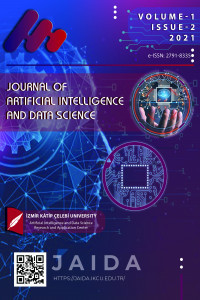Turkish Character Usage in Text Classification
Turkish Character Usage in Text Classification
___
- [1] S. Alp and E. Öz, Makine Öğrenmesinde Sınıflandırma Yöntemleri ve R Uygulamaları. Nobel Akademik Yayıncılık, 2019.
- [2] H.B. Akın and E. Şentürk, "Bireylerin Mutluluk Düzeylerinin Ordinal Lojistik Regresyon Analizi ile İncelenmesi", Öneri Dergisi, vol. 10, no. 37, 183-193, 2012.
- [3] S. Swaminatah, "Logistic Regression- Detailed Owerview. Towards Data Science." towardsdatascience.com, 2018 [Online]. Available: https://towardsdatascience.com/logistic-regression-detailed-overview-46c4da4303bc, 2018. [Accessed: Jan. 15, 2021]
- [4] Ö. Şahin, "iOS platformunda görme engelliler için TL tanıma uygulaması" Yüksek Lisans Tezi, T.C. Selçuk Üniversitesi, Fen Bilimleri Enstitüsü, Konya, 73, 2017.
- [5] B. Aleksey, "Linear and non-linear activation, and softmax." Kaggle.com, 2018 [Online]. Available:https://www.kaggle.com/residentmario/linear-and-non-linear-activation-and-softmax, 2018. [Accessed: Jan. 13, 20201]
- [6] F. Doğan and İ. Türkoğlu, "Derin Öğrenme Modelleri ve Uygulama Alanlarına İlişkin Bir Derleme", Dicle Üniversitesi Mühendislik Fakültesi DÜMF Dergisi, vol. 10, no. 2, 409-445, 2019.
- [7] G. Silahtaroğlu, Veri Madenciliği Yöntemleri. Papatya Yayıncılık, İstanbul, 2013.
- Yayın Aralığı: Yılda 2 Sayı
- Başlangıç: 2021
- Yayıncı: İzmir Katip Çelebi Üniversitesi
A Novel Approach for Detecting Defective Expressions in Turkish
Modeling and optimum design for wire electrical discharge machining of γ titanium aluminide alloy
Social Distancing Automation Software Based on Cloud
Modeling and Design Optimization to Determine the Mechanical Properties of a Recent Composite
Özlem AKTAŞ, Berkay COŞKUNER, İlker SONER
A Face Authentication System Using Landmark Detection
Identification of Breast Cancer Metastasis Using Boosting Algorithms on Cytopathologic Data
